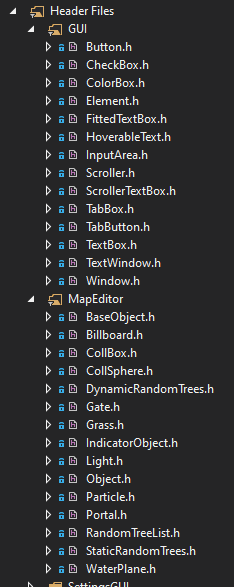Impressive Title MapMaker
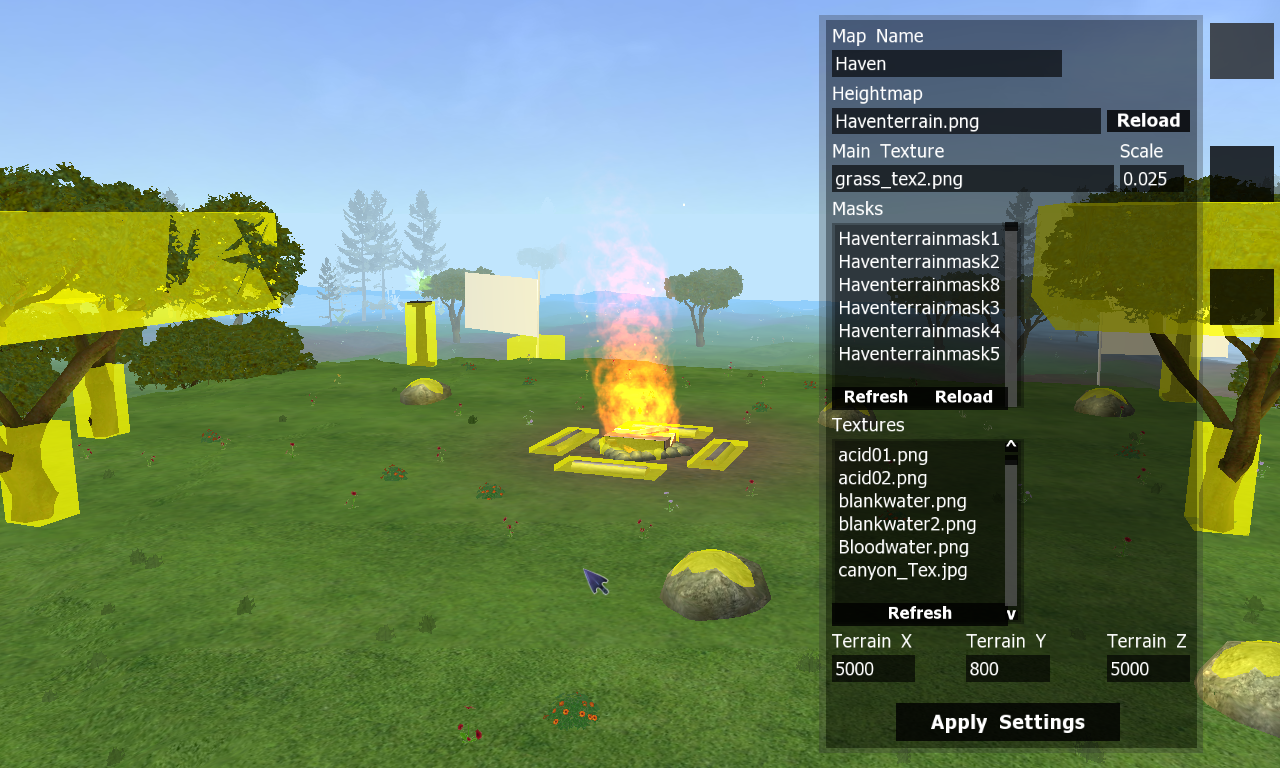
The Impressive Title MapMaker is an editor utility program made for the Impressive Title source code. Its purpose is to provide an easy interface and real-time visuals in order to create map environments for the game. This includes laying out a terrain material with mask and terrain textures, applying a heightmap and reloading it to view changes, tweaking the map settings like weather and effects, and placing and editing objects of various types in the world.
Table of Contents
- Table of Contents
- Impressive Title
- The Problem
- The Solution
- Initial Release Features
- New Version 2 Features
- Coding Practices
Impressive Title
Impressive Title was an online animal chat sandbox inspired by The Lion King […], with feline-like player models and tools that allowed the community to create their own custom made player textures (presets) and maps. […] The original servers ran from 2008 until mid 2010 […] In 2011, after Impressive Title had been closed down for about a year, […] KovuLKD gave out the source code on his Facebook so that anyone could make their own Impressive Title servers. - Glasmar
I got involved with Impressive Title (“IT”) around 2013-14 when some friends and I decided to create our own “server,” or fork of the source code. I wasn’t originally in charge of programming, but an issue came up and I took the files to try to fix it. As I was looking through the code, I realized that the logic and syntax made sense to me, despite having never seen C++ before. I began tinkering with the code that day, and I haven’t stopped programming since.
I began taking simple coding commissions, plugging in various premade codes to clients’ unique IT servers, mainly as an outlet to write code and learn more. I progressed from basic copy/paste/edit features, such as new markings or body parts, to entire systems spanning multiple classes written from scratch, like a way to randomly assign an item color(s) when it spawns and dynamically create the necessary materials. The more I worked, the more I wanted to learn, and I was eager to break away from the repetition of the same source code with different modifications. Thankfully, a client approached me with a new project, separate from but directly related to Impressive Title, which I enthusiastically accepted.
The Problem
Impressive Title is “affectionately” known to be a bit of a disaster, at least to those who work on it directly. The source code itself is not documented at all and a lot of the data structures are set up in a very strict and complicated way. One of the best examples of this is the map system: map environments are generated by reading in several files, the main one being the “.world” file. This is simply a text file with a .world extension that holds (almost) all of the map’s information, including its objects, settings, and name of its terrain file. Here is a simple example:
[Initialize]
MapTerrain.cfg
5000
5000
2500 2500 100
[WeatherCycle]
None
[Object]
acaciaTree.mesh
2538.16 335.373 1951.99
1 1 1
0 0 0
The format may be fairly clear (once you understand the position of the numbers), but consider a finished map:
Click me for lots of text!
[Initialize] Haventerrain.cfg 5000 5000 2570 1088 0 [WeatherCycle] Petals [Music] GonnaStart.mp3 [Trees] HavenTrees.cfg [Bushes] HavenFlowers.cfg [Grass] grass Havengrassdensity.png grass_tex2.png [Portal] 4814 655 4786 25 Lava [Portal] 239 645 4950 25 Waterfall [Portal] 4820 835 69 25 Ascension Island [Portal] 60 300 60 25 Forest [Portal] 555 280 1960 25 Ranch [Gate] GateMatBlack 1875 200 3575 The Void 2010 2990 1955 [Portal] 3805 275 2345 25 ReallyBig [WaterPlane] 4629.4 481 4676 1 1.2 Terrain/Magma lava1.wav false 1 [WaterPlane] 3200 213 2500 13 13 Terrain/LargeWater water1.wav [Object] rectangleslab.mesh 420 606 4700 300 5 450 0 335 0 no sound Wfall [Particle] Bonfire 4831.03 358.407 3478.85 fireloop.wav 0 0 0 [Particle] Bonfire 4921.79 420.694 3820.91 fireloop.wav 0 0 0 [Particle] Bonfire 3746.97 376.931 4947.91 fireloop.wav 0 0 0 [Particle] Bonfire 3580.13 345.69 4922.56 fireloop.wav 0 0 0 [Particle] WaterSplash 164.035 511.373 3589.87 0 0 0 [Particle] WaterSplash 1280.94 511.373 4428.33 0 0 0 [Particle] WaterSplash 50 617.663 3989.03 0 0 0 [Particle] WaterSplash 1042.53 618.039 4896.3 0 0 0 [Object] Waterfall.mesh 611 615 4245.2 3 1.3 2.75 0 152.5 0 [Particle] WaterSplash 875.033 215 4217.38 water1.wav [Particle] WaterSplash 853.424 215 4205.36 water1.wav [Particle] WaterSplash 834.037 215 4195.71 water1.wav [Particle] WaterSplash 814 215 4184 water1.wav [Particle] WaterSplash 796 215 4173 water1.wav [Particle] WaterSplash 776 215 4162 water1.wav [Particle] WaterSplash 756 215 4151 water1.wav [Particle] WaterSplash 736 215 4140 water1.wav [Particle] WaterSplash 716 215 4129 water1.wav [Particle] WaterSplash 694 215 4118 water1.wav [Particle] WaterSplash 674 215 4107 water1.wav [Particle] WaterSplash 654 215 4096 water1.wav [Particle] WaterSplash 654 215 4096 water1.wav [Particle] WaterSplash 634 215 4085 water1.wav [Particle] WaterSplash 614 215 4074 water1.wav [Particle] WaterSplash 596 215 4063 water1.wav [Particle] WaterSplash 576 215 4052 water1.wav [Particle] WaterSplash 556 215 4041 water1.wav [Particle] WaterSplash 536 215 4030 water1.wav [Particle] WaterSplash 516 215 4019 water1.wav [Particle] WaterSplash 494 215 4008 water1.wav [Particle] WaterSplash 474 215 3997 water1.wav [Particle] WaterfallSmoke 875.033 215 4217.38 waterfall.mp3 [Particle] WaterfallSmoke 834.037 215 4195.71 no sound [Particle] WaterfallSmoke 796 215 4173 no sound [Particle] WaterfallSmoke 756 215 4151 no sound [Particle] WaterfallSmoke 716 215 4129 no sound [Particle] WaterfallSmoke 674 215 4107 no sound [Particle] WaterfallSmoke 654 215 4096 no sound [Particle] WaterfallSmoke 614 215 4074 no sound [Particle] WaterfallSmoke 576 215 4052 no sound [Particle] WaterfallSmoke 536 215 4030 no sound [Particle] WaterfallSmoke 494 215 4008 no sound [Particle] Snowflake 4774.68 960 193.804 [Particle] Snowflake 4950 960 50 [Particle] Snowflake 4633.71 960 50 [Particle] Snowflake 4950.777 950 238.081 [Object] jbridge.mesh 740 220 2460 8 7 17 0 95 0 [CollSphere] 760 200 2460 38 [CollBox] 760 225 2460 220 5 50 [Particle] Geyser 4673 481 4595 [Particle] Steam 3677 213 4019 [Particle] Steam 3605 213 4073 [Particle] Steam 3535 213 4129 [Particle] Steam 3753 213 3967 [Particle] Steam 3849 213 3914 [Particle] Steam 3918 213 3823 [Particle] Steam 3998 213 3796 [Particle] Steam 4075 213 3732 [Particle] Steam 4160 213 3675 [Particle] Steam 4147 213 3660 [Particle] Steam 4228 213 3604 [Particle] Steam 4262 213 3520 [Particle] Steam 4283 213 3433 [Particle] Steam 4282 213 3359 [Object] den.mesh 80 292 80 20 20 20 0 50 0 [Object] TangleWell.mesh 460 229 2198 5 5 5 0 0 0 [CollSphere] 460 268 2198 15 [Object] woodsign.mesh 1073 430 4316 1 1 1 0 125 0 [Object] log5.mesh 2560 360 2275 10 18 10 0 180 90 [Object] log5.mesh 2560 355 2275 10 18 10 32 0 90 [Object] log5.mesh 2560 360 2275 10 18 10 0 45 95 [Particle] Bonfire 2560 370 2275 fireloop.wav 0 0 0 [Particle] BonfireSpark 2560 370 2275 fireloop.wav 0 0 0 [Light] 2560 370 2275 1 0.85 0 [CollBox] 2560 350 2275 35 10 35 [Object] log1.mesh 2605 350 2275 5 20 5 0 90 270 [CollBox] 2605 350 2275 20 4.5 55 [Object] log1.mesh 2515 350 2275 5 20 5 0 90 270 [CollBox] 2515 350 2275 20 4.5 55 [Object] log1.mesh 2560 350 2320 5 20 5 0 0 270 [CollBox] 2560 350 2320 55 4.5 20 [Object] log1.mesh 2560 350 2230 5 20 5 0 0 270 [CollBox] 2560 350 2230 55 4.5 20 [CollBox] 2870 350 2015 20 61.5 20 [CollBox] 2255 340 2015 20 62 20 [CollBox] 2255 340 2750 20 62 20 [CollBox] 2870 340 2750 20 62 20 [Billboard] 2870 430 2015 40 40 AirCloud [Billboard] 2255 420 2750 30 30 WaterDrop [Billboard] 2255 420 2015 30 30 EarthLeaf [Billboard] 2870 420 2750 30 30 FireFlame [CollSphere] 2361 348 2178 18 [CollSphere] 2422 351 2585 18 [CollSphere] 2650 351 2456 18 [CollSphere] 2809 351 2474 18 [CollSphere] 2659 351 2168 18 [CollSphere] 2815 351 2076 18 [CollBox] 1033 436 4322 20 43 20 [CollBox] 1033 524 4322 150 45 150 [CollBox] 2446 247 3410 20 43 20 [CollBox] 2446 335 3410 150 45 150 [CollBox] 3061 241 1874 20 43 20 [CollBox] 3061 329 1874 150 45 150 [CollBox] 3709 238 2190 20 43 20 [CollBox] 3709 326 2190 150 45 150 [CollBox] 401 235 2289 20 43 20 [CollBox] 401 323 2289 150 45 150 [CollBox] 2237 348 2337 20 43 20 [CollBox] 2237 436 2337 150 45 150 [CollBox] 2349 348 2465 20 43 20 [CollBox] 2349 436 2465 150 45 150 [CollBox] 2503 342 2761 20 43 20 [CollBox] 2503 430 2761 150 45 150 [CollBox] 2830 351 2316 20 43 20 [CollBox] 2830 439 2316 150 45 150 [Object] Cylinder.mesh 2395 250 4775 17 200 17 0 0 0 no sound LaunchPad [Gate] GUIMat/invisible 2395 355 4775 Launch Room 500 280 [Object] woodsign.mesh 2395 232 4720 1 1 1 0 180 0 no sound warningskills [Light] 2870 420 2750 1 0.85 0 250 [Light] 2870 430 2015 0.75 0.74 0.72 250 [Light] 2255 420 2750 0 1 0.74 250 [Light] 2255 420 2015 0 1 0.24 250 [HPBox] 2562 360 2275 40 40 40 -5 #
Now you have lines and lines and lines of data, all written and entered by hand. And that’s only the .world file; in this specific map, several hundred more objects are stored in two separate .cfg files. There were simple utilities to alleviate some of this, such as a basic “gardener” program that would randomly place trees within a specific range, but the brunt of the work fell on the person creating the map.
Another big issue was collision. The game does not have any kind of automatic collision detection; the only way to make an object solid is to manually place box and sphere areas, named CollBoxes and CollSpheres, that stop the user’s movement. These boxes and spheres are internal objects, so they are never actually rendered in the world, meaning they are invisible to the user trying to place them. You had to rely soleley on the map coordinates, math calculations, and guesstimation to place accurate collision markers.
The sequel to Impressive Title, FeralHeart, has its own built-in mapmaker that lets you actively create and place objects then export a file of the proper type to add it ingame. Users would often create maps in this program then manually convert them to Impressive Title, as the formats were similar, but not exact. It was tedious, but still better than doing everything in IT. Collision, however, still had to be manually done, as FeralHeart used raycasting for accurate automatic collision detection.
The Solution
Enter the Impressive Title MapMaker. It was inspired by the FeralHeart editor, and has similar functionality, though its code is completely separate. Its simple design allows users to enter map details and grab-and-place objects in an intuitive way, reducing the time and effort put into mapmaking significantly. Once they are finished, the program automatically exports their work into files readable by Impressive Title, allowing them to “plug and play” by copy/pasting the files to the proper location and running the game.
Screenshots
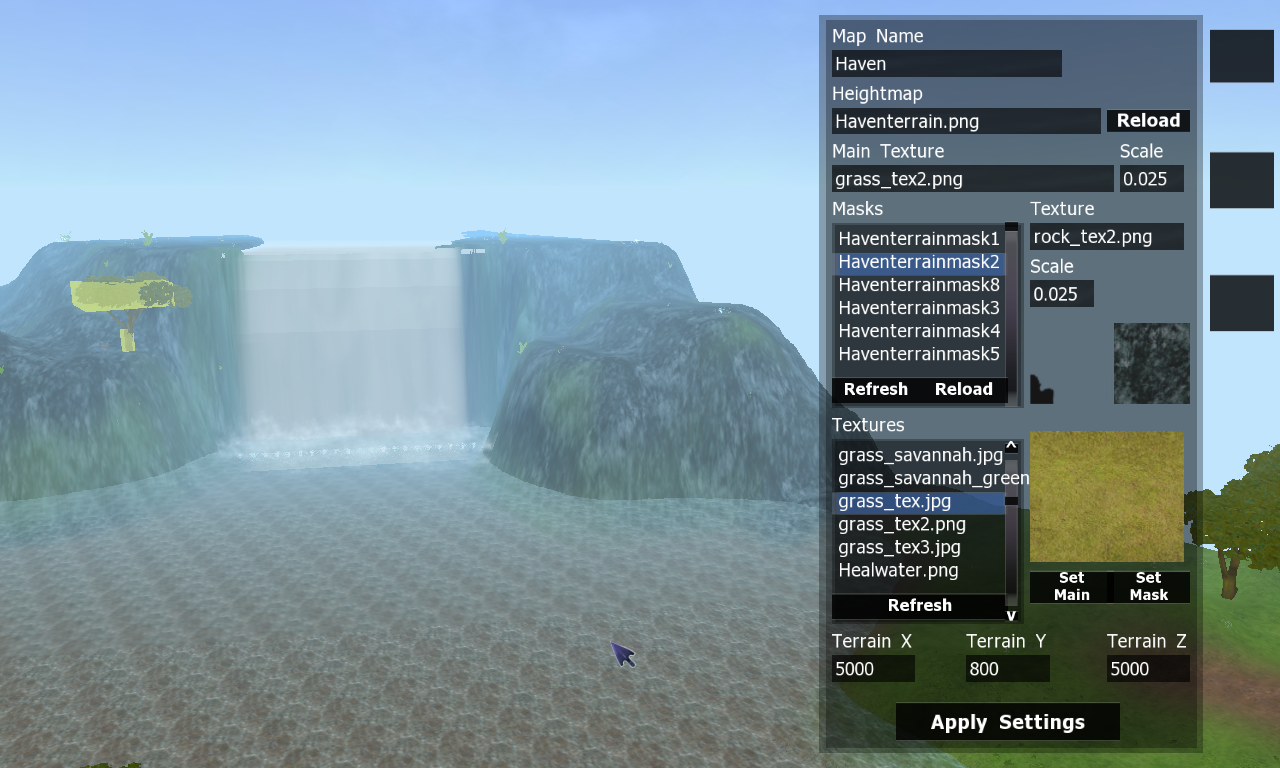
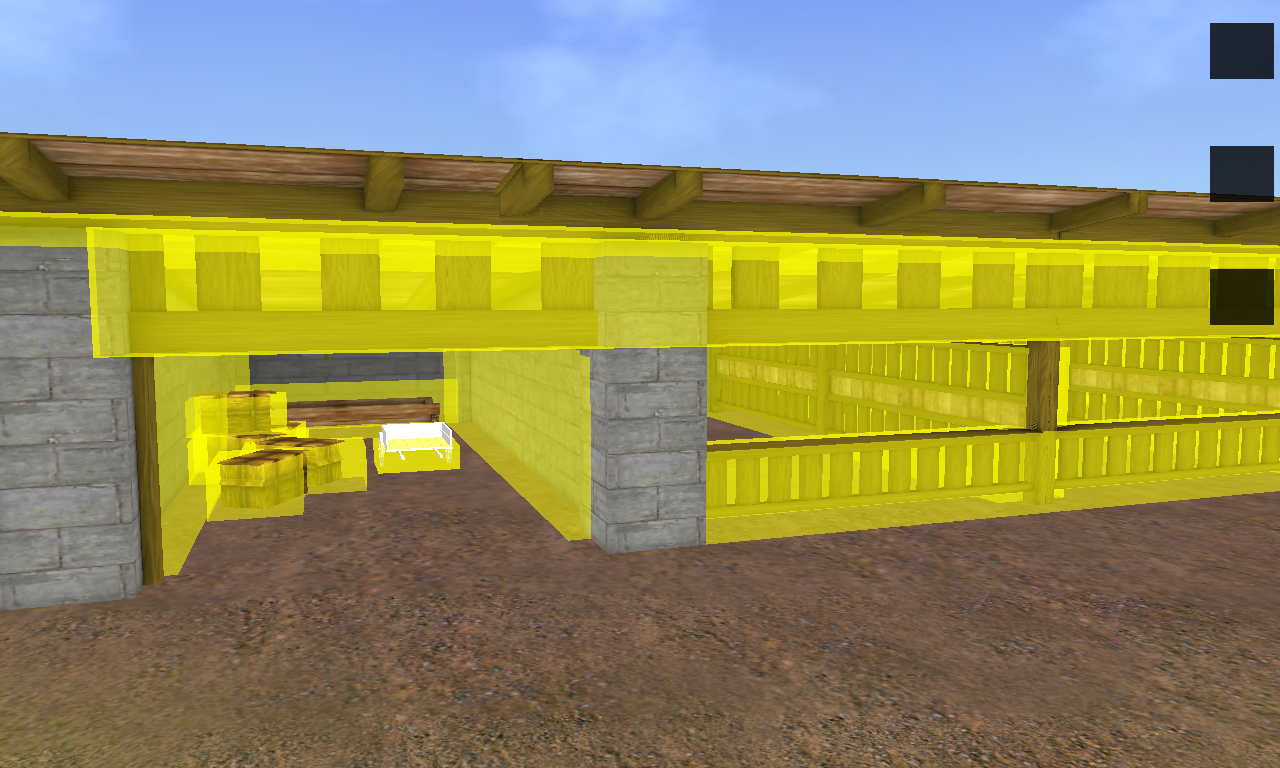
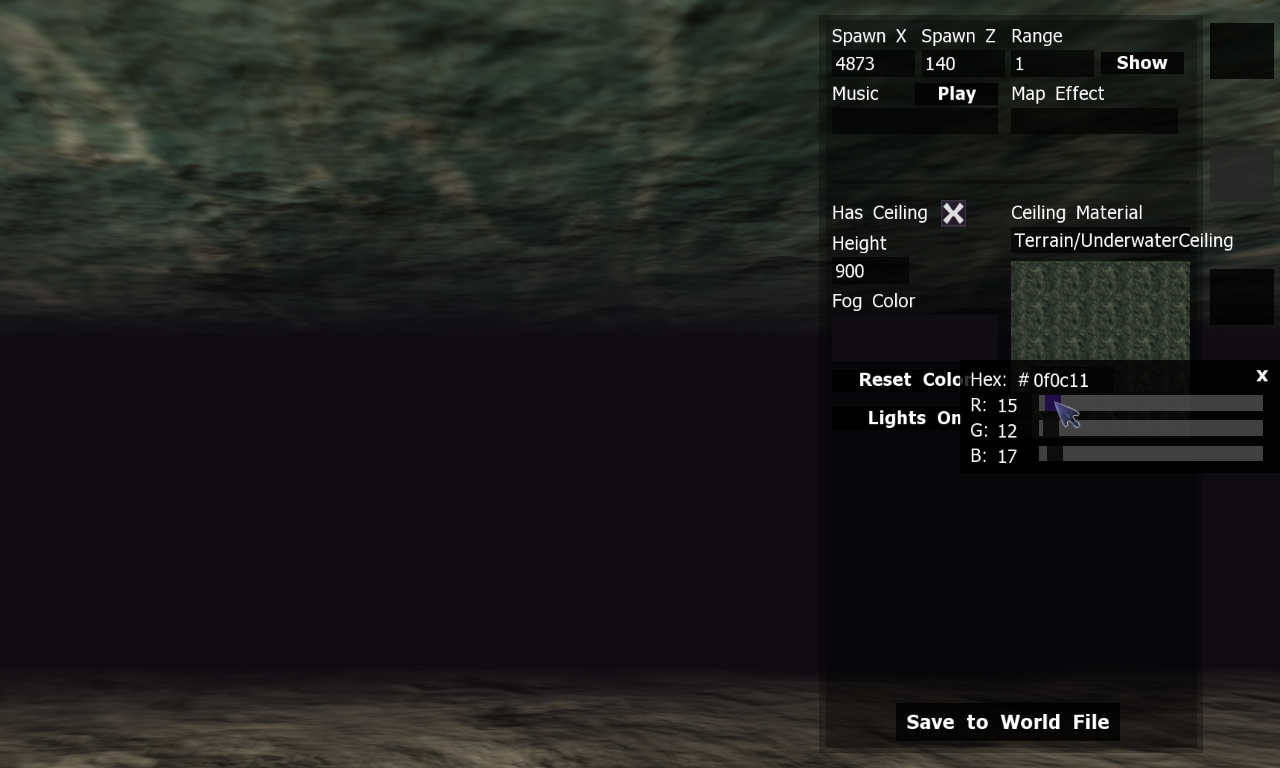
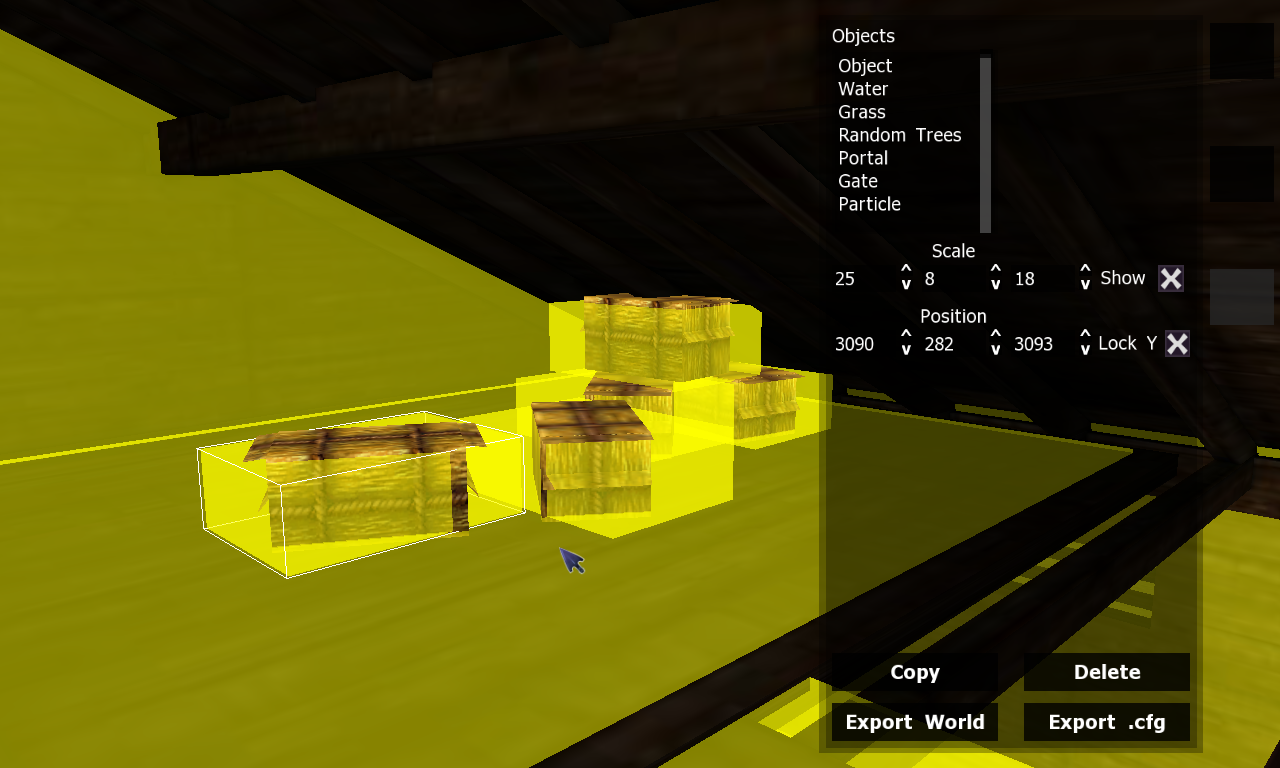
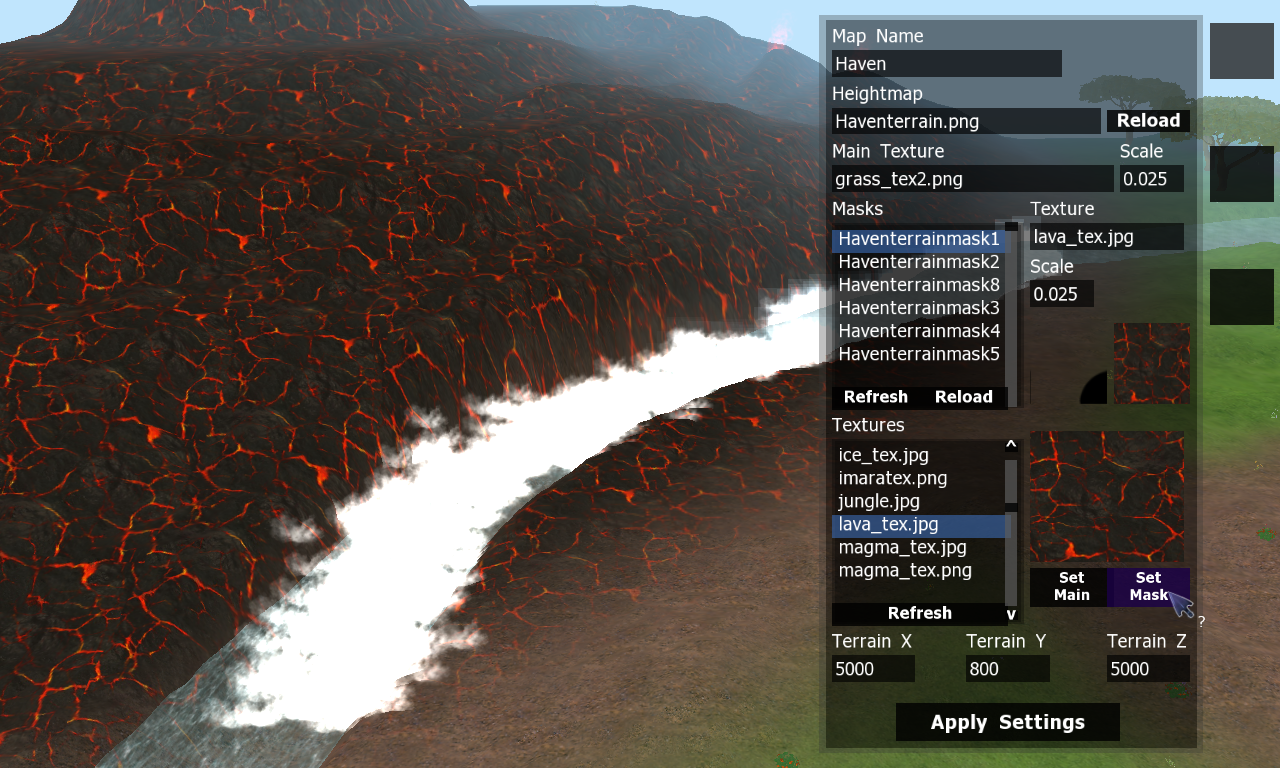
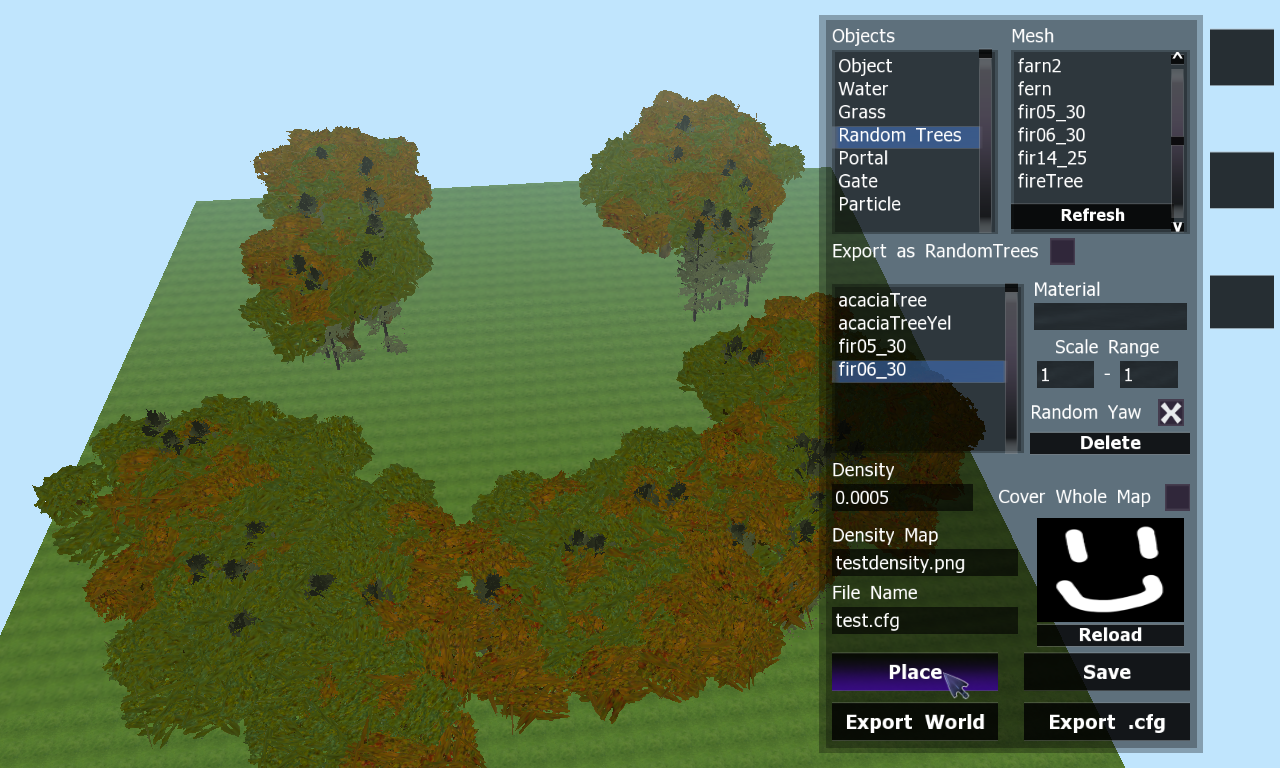
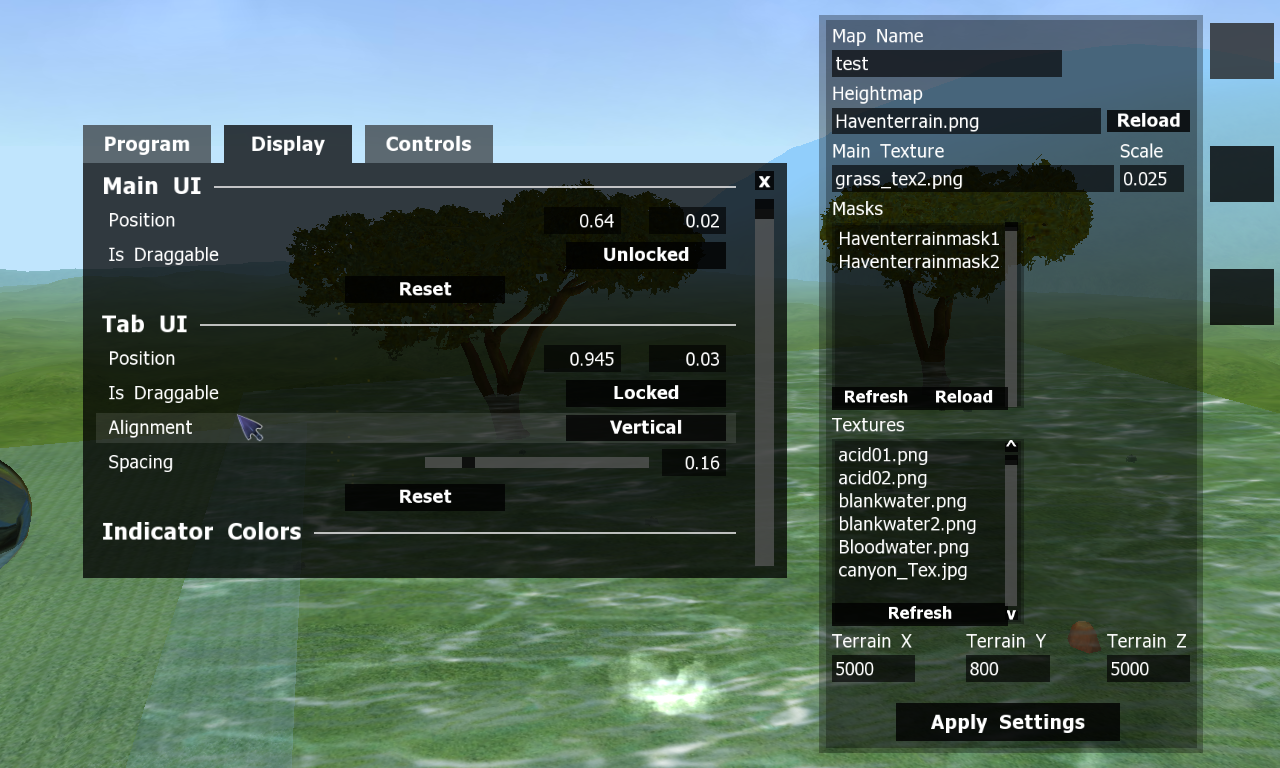
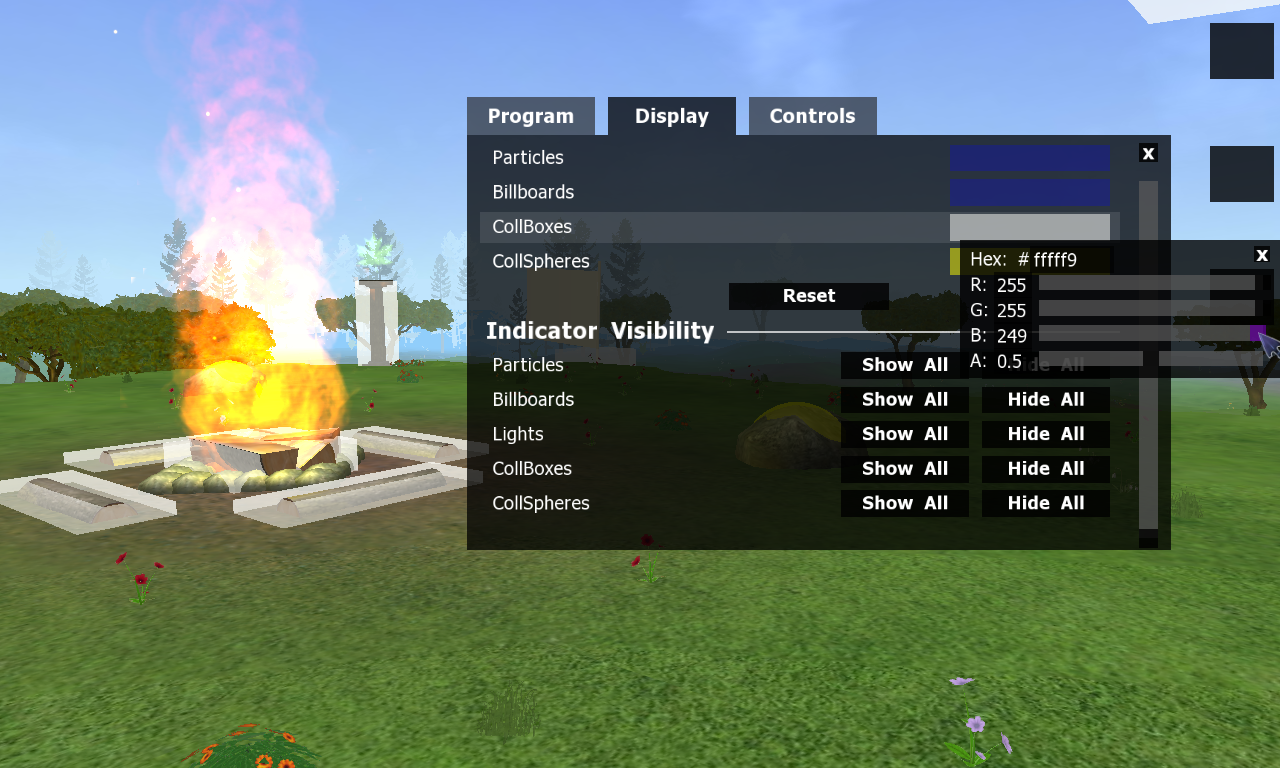
The program is currently released, though the stable version is very basic in design and functionality. Simply put, it works, but it isn’t always very fun to use (although still significantly better than the old method). Because of this, I have been working on a major Version 2 update for the last few months (April ‘22 - present) with several quality-of-life changes, as well as some major code refactoring to make my own life easier and, hopefully, the program more efficient.
Initial Release Features
Terrain Features
- Set the size and height of the terrain
- Apply a heightmap and reload the image to see changes instantly
- Automatically generate a terrain material by adding and layering terrain masks
Map Settings Features
- Set the map’s default spawn point/range and view it with a visual indicator
- Ability to add Music, MapEffect, FreezeTime, and Weather map options
- Checkbox to add a ceiling to the map and set its material
- Option to turn on ambient light in maps with ceilings so it’s easier to see
Object Features
- The ability to add Objects, WaterPlanes, Grass, RandomTrees, Portals, Gates, Particles, Lights, Billboards, CollBoxes, and CollSpheres
- Placeable objects can all be directly picked up and dragged across the terrain to place them visually in real-time
- All object attributes can be directly edited via the UI (such as position, scale, rotation, material, etc)
- Particles, Lights, and Billboards have the option to show a visual indicator of their center
- CollBoxes and CollSpheres have visual indicators
- Includes a new random object generator that uses a black and white density map to scatter objects on terrain in specific areas
New Version 2 Features
- CTRL+Z/CTRL+Y functionality to undo/redo the last 10 object changes
- A brand new Settings box with its own design and functionality, all written from scratch
- Help Pop-Ups that show and give more detail if you hover certain elements
- A temporary storage system that exports unsaved object changes to a file that can be recovered if the program crashes/closes unexpectedly
- The ability to customize the UI position, tab spacing/alignment, indicator colors, and sensitivity of the up/down arrow buttons on object attributes
- The ability to customize the program’s keybinds
- A “Retry” button on File Not Found errors that reloads the resource group to capture any changes and tries the action again
- UI elements moved to their own individual classes
- Added GUI namespace
- Added Element base class that all element types derive from
- Map objects moved to their own individual classes
- Added MapEditor namespace
- Added BaseObject abstract base class that all objects derive from
In the above links are specific examples from select features that best showcase my programming abilities. The full source code is hosted in a private repository, but access can be granted upon request.
It is still in active development and its progress is tracked on Trello.
Coding Practices
Encapsulation
All GUI and Map objects are separated into their own classes for a clean, modular structure. All class member variables are protected and only changed or retreived via accessors/mutators and other public class functions.
Abstraction
All object functionality is contained inside its class; any action can be performed with a simple, concise function call.
Object.cpp
void Object::create(SceneManager* sceneMgr, const int& id, const Vector3& position)
{
// Create entity and node
mEntity = sceneMgr->createEntity(OBJECT_TYPE_NAME[mType] + StringConverter::toString(id), mMesh + ".mesh");
mEntity->setQueryFlags(MOVABLEOBJECT_MASK);
mNode = sceneMgr->getRootSceneNode()->createChildSceneNode(OBJECT_SCENENODE_PREFIX + StringConverter::toString(id));
mNode->attachObject(mEntity);
// Apply attributes
mNode->setScale(mScale);
// Translate PYR rotation
if (mRotation.x != 0) mNode->pitch(Degree(mRotation.x));
if (mRotation.y != 0) mNode->yaw(Degree(mRotation.y));
if (mRotation.z != 0) mNode->roll(Degree(mRotation.z));
// Apply material if exists
if (!mMaterial.empty())
{
mEntity->setMaterialName(mMaterial);
}
// Set position
setPosition(position);
}
MapManager.cpp
void MapManager::addObject(const String& meshName)
{
// Create a new world object
Object* tNewObject = new Object(meshName);
// Create actual Object
tNewObject->create(mSceneMgr, getNextAvailableID()); // << Object is created in the scene, we don't need to know how
// Add to object list
mPlacedObjects.push_back(tNewObject);
// Set as current object
setSelectedObject(mPlacedObjects.back());
mIsPlacingObject = true;
}
Inheritance
These object classes each have their own base class per-type that contains any shared attributes. This cuts down on duplicate code and makes it easier to add new objects of each type.
For example, all Map Objects derive from BaseObject, as they all share the class member variables:
class BaseObject
{
protected:
// SceneNode of the object
SceneNode* mNode;
// Actual entity
Entity* mEntity;
// Type of object it is
int mType;
// If locked, the Y never changes; if unlocked, it snaps to the terrain height
bool mLockY;
// ...etc
Polymorphism
Map objects are polymorphic classes with an abstract BaseObject base class that controls them via the MapManager. Objects are all stored and accessed via BaseObject pointers, which are either cast if they need to access class-specific data:
const String MapManager::getSelectedObjectMesh()
{
return static_cast<Object*>(mSelectedObject)->getMesh(); // cast to Object since Mesh is unique to Objects
}
or called on the BaseObject and polymorphically checked for overrides:
virtual void setPosition(const Vector3& position);
...
// All but CollBoxes pass their position directly to the SceneNode
void BaseObject::setPosition(const Vector3& position)
{
mNode->setPosition(position);
}
// CollBoxes use a different Y value, so it must use different position functions
void CollBox::setPosition(const Vector3& position)
{
// Save passed Y
mExportedY = position.y;
// Set node position based on scale
mNode->setPosition(position.x,
mExportedY + (mScale.y / Real(2.0)),
position.z);
}
// mSelectedObject is a BaseObject pointer - if it's a CollBox, it'll use the proper function
mSelectedObject->setPosition(mPosition);
